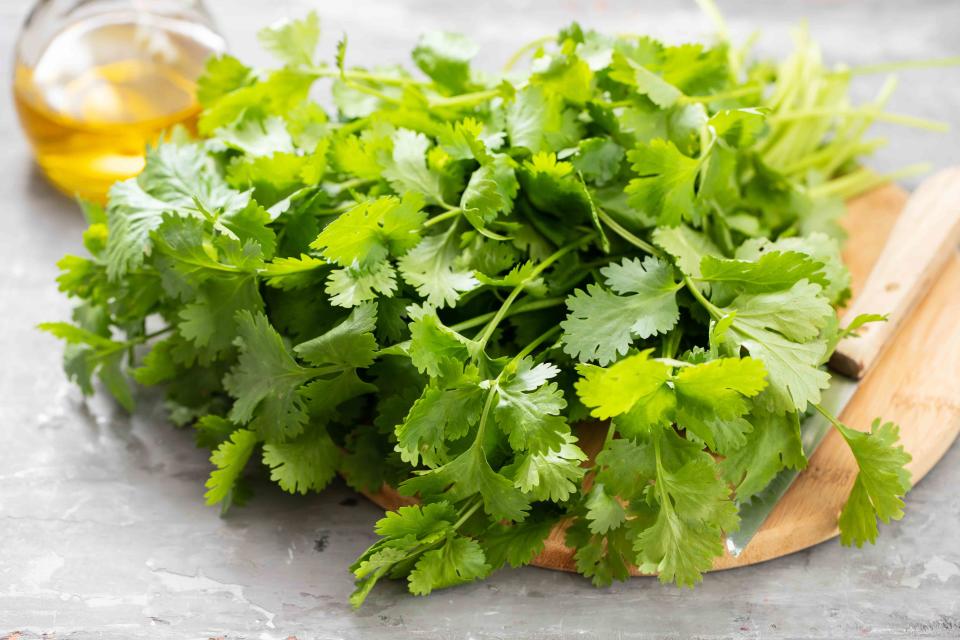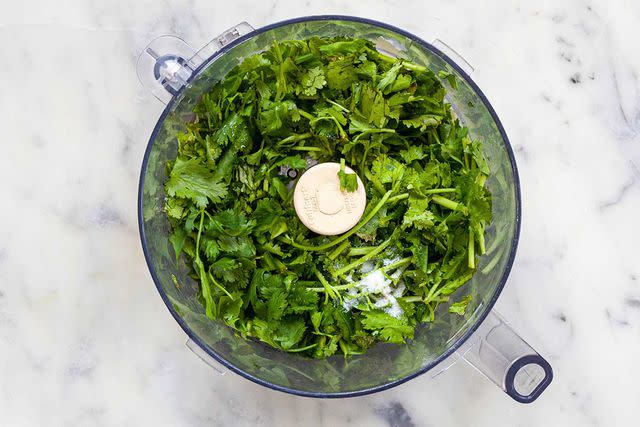The Only Way You Should Store Cilantro So It Lasts
The experts weigh in on how to keep your cilantro fresh for longer.

Simply Recipes / Getty Images
You come home from the grocery store with a big bunch of fresh cilantro. Whether you’re making salsa, soup, or guacamole, there’s only one way to keep your green bundle from getting gross and slimy.
“There are lots of ways to store cilantro but my favorite is like a bouquet of flowers in a jar with a little water for the stems and then add a loose plastic bag on top of the leaves to maintain the moisture,” says registered dietitian and professional chef John “Wesley” McWhorter, a national spokesperson for the Academy of Nutrition and Dietetics. “Too much water equals slime and too little water equals limp, shriveled leaves.”
Registered dietician and chef Melanie Marcus suggests storing the cilantro bouquet upright in a glass with about an inch of water on the bottom.
“I usually keep it on the counter so I can use it quickly, but for longer-term storage top with a plastic bag to create a greenhouse effect and store it in the fridge for at least two weeks,” says Marcus.
Registered dietitian Grace Derocha, a national spokesperson for the Academy of Nutrition and Dietetics, says she has a bunch of Mason jars in her refrigerator door for storing herbs like cilantro in this easy and effective way.
“Another popular trick is to store cilantro in a damp cloth or towel and toss it in a sealable plastic bag,” says Derocha, who cautions that the details matter with this technique. “This method can help cilantro last a few days longer, but an overly wet towel can make the cilantro leaves mushy and rotten. One bad cilantro leaf can quickly spoil the rest so get rid of any spoiled cilantro leaves or stems.”

What Causes Cilantro To Get Slimy
Cilantro can get slimy when excess moisture is left on the leaves and when it starts to age. Experts disagree whether slimy cilantro is OK to use.
“While slimy cilantro isn't necessarily unsafe, it's a sign of degradation, leading to some reduction in flavor,” says McWhorter. “However, this is a great time to use it in a soup or dish that doesn’t need to look ‘perfect.’ Don’t throw it out.”
Derocha disagrees. “I would not use slimy cilantro, but I would definitely put it into my compost to be reused and recycled in a different way.”
Marcus suggests perking up cilantro if it’s gone limp. “You can often revive it by submerging it in ice water for 30 seconds to perk up,” she says. “However slimy cilantro should be discarded.”
To Wash or Not to Wash Cilantro Before Storing
“I recommend washing cilantro right before using it, rather than washing before storing with the risk of excess moisture that can lead to spoiling faster,” Derocha suggests.
If you opt to wash it immediately, make sure to dry it well.
“Rinse and dry cilantro thoroughly with a salad spinner, especially if it was under the mister at the supermarket,” Marcus suggests. “This helps to remove any debris that could have accumulated on the shelf and extend its lifespan.”

Simply Recipes / Karishma Pradhan
The Best Place To Store Cilantro
The best places to store cilantro in the refrigerator are the vegetable drawer (if you have one) or the refrigerator door.
“Avoid the area of the fridge where the cold air is blowing. There’s a higher likelihood of freezing,” says McWhorter.
Properly stored this way, it should last as long as two weeks. For peak flavor and freshness, use it within a few days or no longer than a week. You can skip the refrigerator if you’ll be using the cilantro quickly.
“If you plan to use cilantro within two to three days, keeping it on the counter out of direct sunlight will work well and give you a pop of freshness to enjoy looking at,” says Marcus. “But if you need long-term storage, place it in the fridge in a low-traffic area where it will avoid the risk of being knocked over.”
Read the original article on Simply Recipes.


